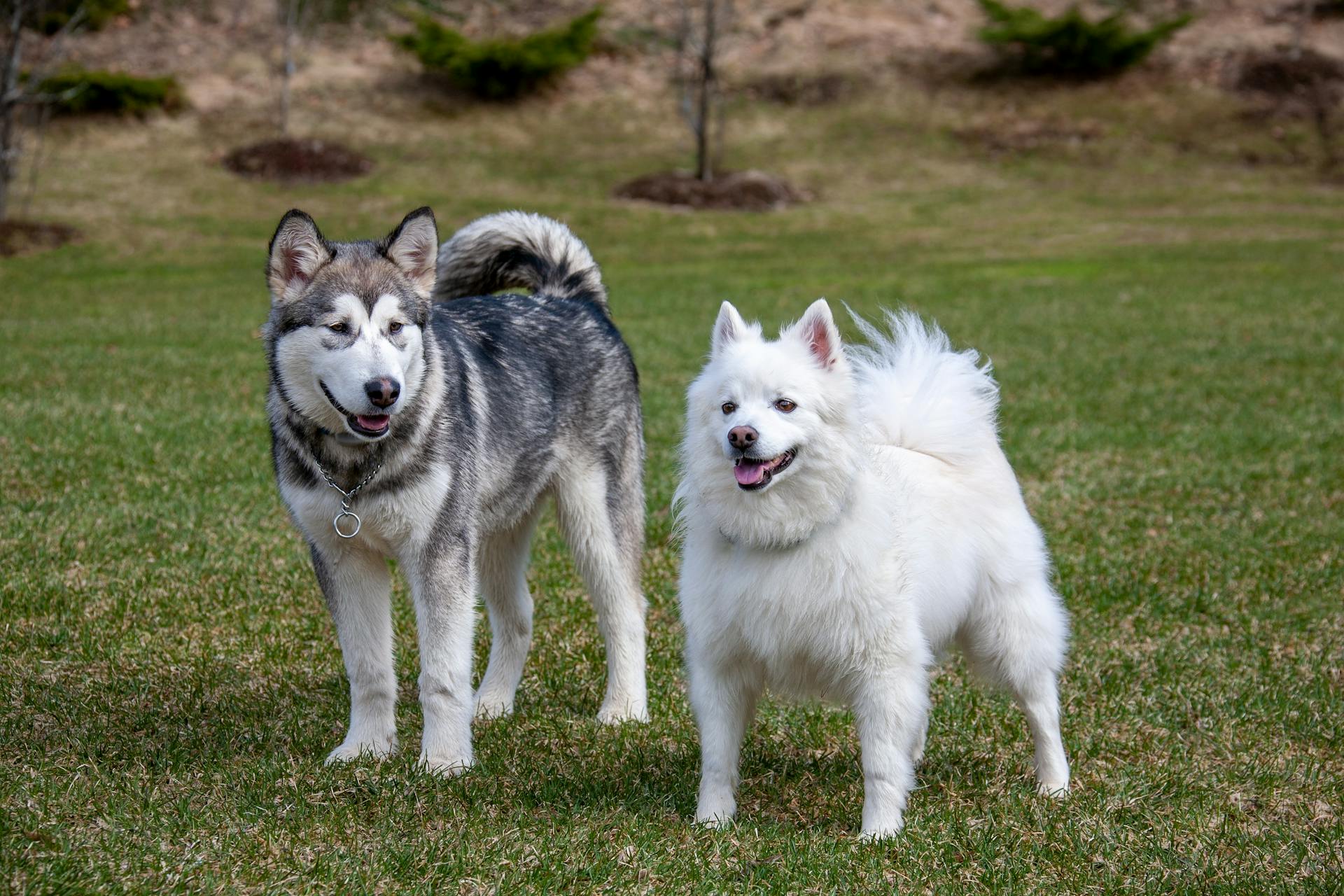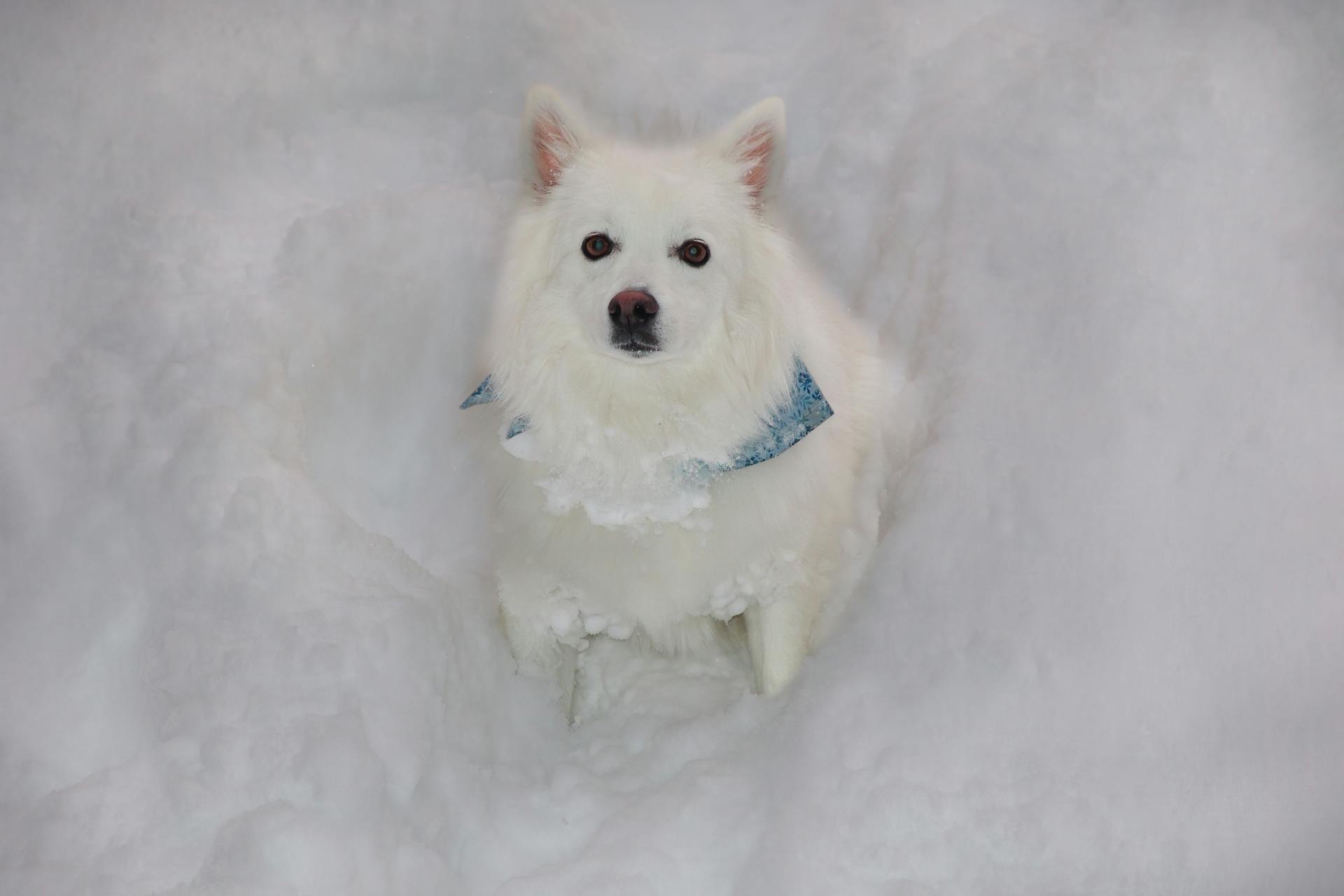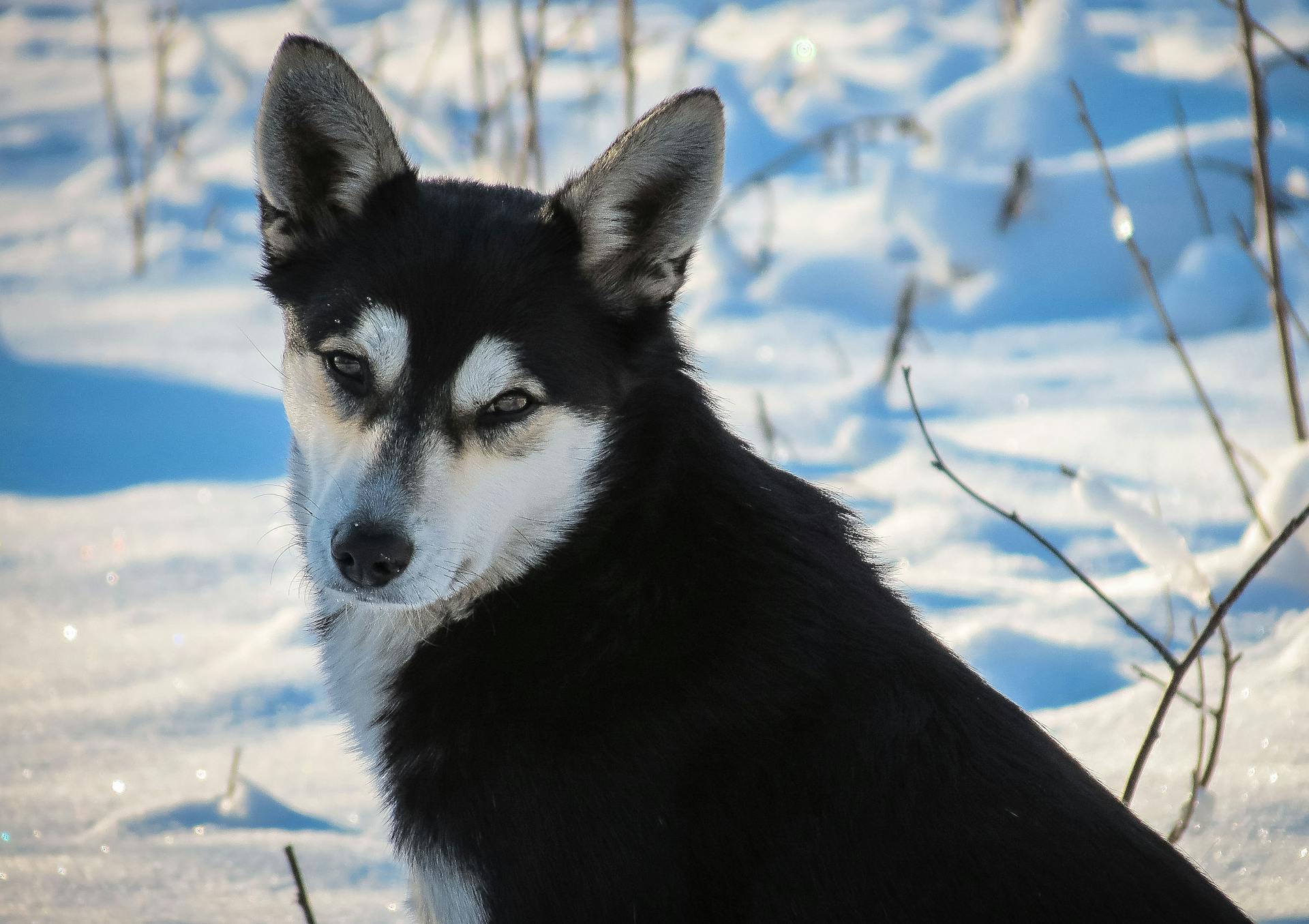
The American Eskimo Dog is a versatile breed that thrives as a companion dog. They can grow up to 19 inches tall and weigh between 19-40 pounds.
Their thick double coat requires regular grooming to prevent matting and tangling. They shed heavily twice a year, so be prepared for regular brushing sessions.
This breed is highly intelligent and trainable, making them a great choice for first-time dog owners. They are also known for their playful and affectionate nature, which makes them a wonderful addition to any family.
Their energy level is moderate to high, requiring daily exercise to keep them happy and healthy. A 30-minute walk or playtime should suffice, but they may require more if they're not getting enough physical activity.
Health and Care
American Eskimo Dogs are generally a healthy breed, but like all breeds, they can be prone to certain health issues. Hip dysplasia and progressive retinal atrophy are two common conditions that can affect the breed.
To ensure your Eskie stays healthy, it's essential to have them vaccinated against Kennel Cough when they're a puppy. You should also ask the breeder for health clearances for both parents, specifically for hip dysplasia, elbow dysplasia, hypothyroidism, and von Willebrand's disease.
Regular exercise is crucial for American Eskimo Dogs, as they can become destructive if they don't get enough physical activity. A daily walk or playtime in the yard should be a must, and they also enjoy water play and playing in the snow.
American Eskimo Dogs are generally happy and adaptable, but they can suffer from separation anxiety if left alone for long periods. To avoid this, it's best to keep them indoors and provide plenty of toys and stimulation to keep them occupied.
Health Issues
American Eskimo Dogs are generally a healthy breed, but like all dogs, they can be prone to certain health issues.
Hip dysplasia is a common condition that affects the breed, where the thighbone doesn't fit snugly into the hip joint. This can lead to arthritis as the dog ages.

Progressive retinal atrophy is another condition that affects the breed, where the photoreceptors in the retina degenerate, leading to loss of vision.
Legg-Calve-Perthes Disease is a malady that involves the hip joint, where the blood supply to the head of the femur is decreased, causing the head of the femur to disintegrate.
Juvenile cataracts can also be a problem for some relatively young Eskies, causing vision loss.
It's essential to ensure that your Eskie is vaccinated against health issues such as Kennel Cough when they're a pup.
To ensure you're buying a healthy puppy, find a good breeder who will show you health clearances for both your puppy's parents. Health clearances prove that a dog has been tested for and cleared of a particular condition.
Here are some health tests that are recommended by the National Breed Club:
- Hip Evaluation
- PRA Optigen DNA Test
- Ophthalmologist Evaluation
If you're buying a puppy, be sure to ask the breeder if her stock is certified by the Canine Eye Registration Foundation, and ask to see the certificates.
Care

American Eskimo Dogs are highly energetic and require regular exercise to stay happy and out of trouble. They love to play in the snow and water, and their energy helps them keep up with busy households.
To prevent destructive behavior, it's essential to provide your Eskie with plenty of physical and mental stimulation. They do well in households with multiple family members, as their energy can be a great asset.
The breed standard describes the American Eskimo Dog as intelligent, alert, and friendly. They can make wonderful pets for active families and single pet parents alike.
Regular grooming is crucial for your Eskie's coat. They require brushing at least twice a week, with more frequent brushing during periods of heavy shedding in the spring and fall.
Here are the three American Eskimo Dog sizes:
To prevent separation anxiety, it's best to avoid leaving your Eskie alone for long periods of time. When you do need to leave, put him in a crate with plenty of sturdy toys to keep him occupied.
Appearance and Grooming
The American Eskimo is a compact canine with a smooth gait, embodying strength, agility, alertness, and beauty. Their face is a Nordic type with black points and triangular-shaped ears.
Their eyes are keen and intelligent, slightly oval in shape. The preferred coat color is pure white, although cream-colored biscuit is accepted.
The American Eskimo has a double coat consisting of long soft guard hairs that grow through a dense undercoat to form the overcoat. This coat contains oil that prevents dirt from adhering to it.
The American Eskimo is recognized in three sizes: Toy, Miniature, and Standard, with heights ranging from 9 to 19 inches. All classes have a ruff (mane) and a tail that curls at the buttock.
Here's a breakdown of the three sizes:
They require frequent brushing to prevent matting, especially behind the ears. A thorough brushing two to three times a week is advised.
Temperament and Training
American Eskimo dogs are known for their loving and outgoing personalities, making them a great fit for families with children. They are highly social and love to be part of the family.
Their intelligence and eagerness to please make them one of the most trainable breeds, as their history as circus dogs attests. They are quick to learn commands and tricks and excel at obedience and agility competitions.
American Eskimo dogs are alert, intelligent, social, and affectionate, with a big-dog attitude that makes them perky and playful. They are naturally reserved with strangers but fiercely loyal to their families.
They require regular exercise and mental stimulation to avoid mischievous behavior, such as barking and chewing. A bored American Eskimo dog can wreak havoc on your home and yard.
Training games and positive reinforcement methods are essential for these playful dogs, which learn best when training is fun and engaging. They can develop separation anxiety if left alone too often or for too long, so it's essential to provide them with plenty of attention and exercise.
American Eskimo dogs are patient with children who are taught how to interact with them gently, making them a great breed for families with kids. They are also friendly and attentive towards their pet parents, requiring regular opportunities to vent their energy and use their busy minds.
A confident owner who can take charge in teaching and leading them is essential for these strong-willed dogs, which learn quickly but can be rambunctious and bored if left unchallenged.
Related reading: Can Maltese Dogs Be Left Alone
Maintenance and Feeding
The American Eskimo's fur is quite high maintenance, requiring frequent brushing to prevent matting and keep their hair well feathered. Brush your American Eskimo two to three times a week to keep them looking their best.
Their skin is sensitive, so baths should be limited to once every couple of months or as needed. However, it's essential to clean their eyes often due to their prone nature to eye issues and tear staining.
In terms of exercise, American Eskimos are very active and require daily exercise to stay happy and healthy. They can thrive in small spaces, but they do need regular physical and mental stimulation.
Feeding your American Eskimo is relatively straightforward, with a recommended daily amount of 1/2 to 1.5 cups of high-quality dry food, divided into two meals. However, the exact amount may vary depending on your dog's size, age, build, metabolism, and activity level.
Discover more: Shiba Inu Coin 1 Cent
Maintenance
The American Eskimo requires frequent brushing, ideally two to three times a week, to prevent matting and keep their fluffy white fur well feathered.
Their fur contains oil that prevents dirt from adhering to it, making frequent brushing also helpful in keeping your dog clean.
Bathing your American Eskimo should be done sparingly, ideally only once every couple of months, as excessive bathing can irritate their sensitive skin.
Daily exercise is crucial for American Eskimos, who were bred as watchdogs for cooler climates and require regular physical activity to stay happy and healthy.
You should clean your American Eskimo's eyes often, as they are prone to eye issues and tear staining.
Checking your dog's ears for dirt and possible infection is also essential during grooming, and using a pH-balanced ear cleaner can help keep their ears healthy.
American Eskimos are prone to shedding, so you'll need to brush them frequently to remove loose hair and prevent matting.
A good fur remover can also be helpful in managing their shedding, especially during peak shedding seasons.
Their skin can be sensitive, so it's best to bathe them only occasionally, no more than 3-4 times a year, to prevent drying and irritation.
Worth a look: How to Clean Maltese Dogs Eyes
How Much to Feed
To determine how much to feed your American Eskimo Dog, you'll want to consider several factors, including their size, age, build, metabolism, and activity level.
The recommended daily amount of food for an adult Eskie is 1/2 to 1.5 cups of high-quality dry food per day, divided into two meals.
Highly active dogs will need more food than their couch potato counterparts, so be sure to adjust accordingly.
The quality of dog food also plays a role, with better food allowing for smaller portions and a more nourished dog.
For puppies, feeding three to four small meals per day on a regular schedule can help maintain stable blood sugar.
Eskie puppies should be fed a diet formulated specifically for puppies or designated for all life stages.
Your veterinarian can help you determine the best feeding plan for your dog, taking into account their individual needs and factors like neuter status and activity level.
The feeding guide labels on dog food packaging can also provide valuable information for pet parents.
Worth a look: National American Eskimo Day
Size and Size-Related Topics
The American Eskimo Dog comes in three recognized sizes, each with its own unique characteristics.
The smallest size is the Toy, which stands between 9 to 12 inches tall.
The Toy size is the smallest of the three, and dogs that are under 9 inches or over 19 inches are not included in the breed standard set by the AKC.
Here's a quick rundown of the three sizes:
Size
The American Eskimo Dog comes in three sizes: Toy, Miniature, and Standard. Each size has its own unique characteristics.
The Toy size stands between 9 to 12 inches tall. This is the smallest of the three sizes. Dogs that are under 9 inches or over 19 inches are not included in the breed standard.
The Miniature size is slightly larger, standing between 12 to 15 inches tall. This size is perfect for families who want a smaller dog but still want a loyal companion.

The Standard size is the largest of the three, standing between 15 to 19 inches tall. This size is great for families who want a larger dog but still want a dog that is manageable in size.
Here's a comparison of the three sizes:
Keep in mind that these sizes are not ideal, but rather a range of heights and weights that are acceptable for each size.
Similarly Sized
If you're looking for breeds that are similar in size to the American Eskimo, you've got a few options.
The Peruvian Inca Orchid is a great match, with a similarity score of 97%. This breed is known for its small size and gentle nature.
The Petite Goldendoodle is another breed that's similar in size, with a similarity score of 95%. As a cross between a Poodle and a Goldendoodle, this breed is often friendly and energetic.
The English Cocker Spaniel is also a great choice, with a similarity score of 95%. This breed is known for its small size and loving personality.
The Woodle and Kromfohrlander are also similar in size, with similarity scores of 94%. These breeds are often friendly and outgoing, making them great companions.
Here's a list of similar-sized breeds:
- Peruvian Inca Orchid (97% Similar)
- Petite Goldendoodle (95% Similar)
- English Cocker Spaniel (95% Similar)
- Woodle (94% Similar)
- Kromfohrlander (94% Similar)
Frequently Asked Questions
Is an American Eskimo a good family dog?
Yes, the American Eskimo is known to be a loving and affectionate family dog, making it a great addition to many families.
Is an American Eskimo a husky?
No, the American Eskimo dog is not a husky, despite its resemblance to one. It's actually a distinct breed that originated in America's Midwest.
Are American Eskimo dogs yappy?
American Eskimo dogs are known to be vocal and may be considered yappy due to their loud barking nature, which is a result of their original watchdog breeding. If you're considering bringing an Eskie home, be prepared for regular barking and take steps to address excessive noise.
Do American Eskimo dogs bark a lot?
American Eskimo Dogs can be prone to excessive barking, but proper exercise and mental stimulation can help reduce this behavior. Excessive barking may be a concern for some owners, but with the right care, it can be managed.
How much is a standard American Eskimo?
The cost of a standard American Eskimo dog is around $600 to $800. Learn more about their monthly costs and estimated lifetime expenses.
Featured Images: pexels.com


